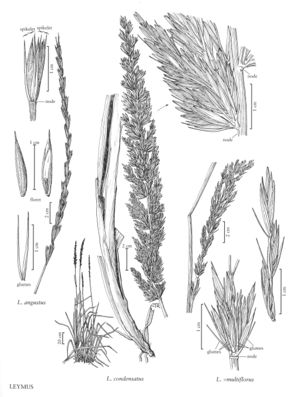Difference between revisions of "Leymus ×multiflorus"
FNA>Volume Importer |
imported>Volume Importer |
||
| Line 43: | Line 43: | ||
|publication year= | |publication year= | ||
|special status= | |special status= | ||
| − | |source xml=https:// | + | |source xml=https://bibilujan@bitbucket.org/aafc-mbb/fna-data-curation.git/src/bb6b7e3a7de7d3b7888a1ad48c7fd8f5c722d8d6/coarse_grained_fna_xml/V24/V24_520.xml |
|subfamily=Poaceae subfam. Pooideae | |subfamily=Poaceae subfam. Pooideae | ||
|tribe=Poaceae tribe Triticeae | |tribe=Poaceae tribe Triticeae | ||
Revision as of 21:48, 27 May 2020
Plants cespitose, rhizomatous. Culms 65-210 cm tall, 3-5 mm thick. Leaves exceeded by the inflorescences; auricles absent; ligules 0.5-2 mm, truncate, erose; blades 6-15 mm wide, both surfaces glabrous, adaxial surfaces with numerous closely spaced, unequal veins. Inflorescences 15-35 cm long, 9-25 mm wide, usually spikes, with 2-6 spikelets per node, occasionally some nodes with 1-2 branches, branches to 60 mm, strongly ascending; internodes 8-10 mm, usually glabrous, sometimes scabrous. Spikelets 17-25 mm, pedicellate, pedicels 0.5-2(5) mm, with 6-9 florets. Glumes 9-25 mm long, differing in length by 1-4 mm, usually exceeding the lowest lemmas, 0.5-2.5 mm wide, subulate to narrowly lanceolate, stiff, keeled, the central portion thicker than the margins, tapering from the bases, glabrous, smooth proximally, scabrous distally, 1(3)-veined, veins inconspicuous at midlength; lemmas 8-12 mm, glabrous, acute to awned, awns to 1.8 mm; anthers about 6 mm, indehiscent. 2n =42.
Discussion
Leymus ×multiflorus is a sterile hybrid between Leymus condensatus and L. triticoides that occurs near the coast of central and southern California.
Selected References
None.
